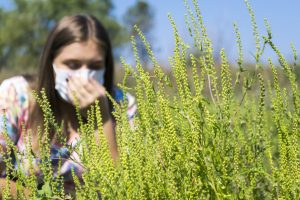FSA/HSA Plans for Allergy Services
Environmental allergies are a common ailment that affects approximately 50 million Americans every year. Whether you suffer from year round or just seasonal allergies, you may be able to use your tax-free FSA/HSA funds to help you save money on education, testing, and treatments. If you struggle with allergy symptoms—itchy eyes, congestion, and non-stop sneezing—you know how tough the spring and summer months can be. Over-the-counter drugs can help, but sometimes these remedies aren’t enough. As you compare options, you may notice the hefty price tag. Luckily, your health savings account (HSA) or flexible spending account (FSA) may offer some savings to your allergy relief.
What Exactly is an FSA or HSA Health Care Plan?
Flexible Spending Accounts (FSA) or Health Savings Accounts (HSA) are medical savings accounts with tax benefits, designed to allow you to set aside pre-tax savings to go towards your treatments, healthcare and other medical expenses.
Can I Use My FSA/HSA Plan for Allergy Testing?
For the majority of healthcare plans environmental and food allergy testing is an eligible FSA/HSA expenditure, meaning they allow the tests as a qualified medical expense. To make sure you're covered, we recommend getting in touch with your provider to confirm your inclusions.
A qualified medical expense is defined in IRS Publication 502 as the cost of treatment, cure, diagnosis, mitigation or prevention of a disease. The expense must be used principally to prevent or help ease the symptoms of a physical/mental illness or disability in order to meet the criteria for HSA and FSA. Environmental sensitivity tests work to identify allergic triggers that may cause discomfort and allow you to avoid or mitigate the exposure. Similarly, food sensitivity tests identify digestive issues so you can alter your diet to try and prevent things like bloating, nausea and stomach cramps.
Other Allergy Related Questions?
Our team wants to help you make the most out of your benefits before they expire on January 1st. Visit our FAQ page for more insight, or find an Allergy Center near you by clicking here.
Ragweed and Fall Pollen Allergies
Back to school season is here! Shorter days, crisp, cool evenings, and beautiful fall foliage are on the horizon. This time also marks the onset of weed pollination and the resurgence of allergy symptoms that may have taken a vacation in the hot, dry July heat. The meteorological calendar says fall begins September 22nd, but weed pollen, the main culprit of the sniffles and sneezes during fall allergy season, is already here!
Pollen Offenders
Towards the close of summer, weeds start to pollinate. Weeds grow all summer, but their pollen is usually not released until later in the growing season. This can vary year to year but typically starts mid to late August. Ragweed, cocklebur, lamb’s quarters, pigweed, dock sorrel, English plantain, and sagebrush can all cause fall allergy symptoms and are widely spread across the U.S.
Specifically ragweed pollen is the predominate culprit of allergy symptoms from August through October, peaking on average in mid-September. Ragweed is one of the major drivers of allergy symptoms and releases huge amounts of pollen each and every day. The pollen produced by ragweed is small and light. It is released in large quantities into the air and carried for miles by the wind. Nasal congestion, runny nose, and itchy eyes are typically caused by wind-blown pollen which is easily spread for miles and miles.
Other Pollen Types
Goldenrod, which blooms at the same time that ragweed does, is instead insect-pollinated and therefore is not a significant allergen for most individuals. Insect carried pollen is produced by plants that have bright and attractive flowers. This kind of pollen is typically large and heavy, sticks to insects, and is transported during flight fertilizing other plants. These bright flowers are commonly thought to be allergy offenders, however because they do not release much pollen into the air they are not as likely the culprit of allergy symptoms.

Manage Symptoms
Checking local pollen counts is helpful to anticipate the level of exposure on any given day. Pollen counts are determined by collecting pollen on special rods. The pollen is then counted under a microscope and calculated in grains per cubic meter of air. Pollen counts tend to be the highest early in the day, or often when the wind picks up just before a large rainstorm. If you like dancing in the fall rain, or jumping in rain puddles, however, you are in luck. During a rainstorm and immediately following, pollen becomes still and dormant because the rain makes it damp and heavy. As the air becomes warmer and drier following the storm, however, the pollen count will rise again.
Pollen Avoidance
Those with weed pollen allergies should try to avoid heavily dense wooded areas or those with brush and shrubbery. These areas should be especially avoided in late August when pollen is the most dense and abundant. Pollen counts are never zero, nor will an allergy sufferer truly be able to avoid weed pollen in the late summer and early fall. However, contact may be lessened by taking simple steps to avoid pollen overload:
- Utilizing the air conditioner or heater
- Keeping the windows and doors at home and in the car closed
- Utilizing the dryer rather than the fresh breeze to dry clothing
- Changing clothes after coming in from being outdoors
- Shower prior to getting into bed or laying on upholstered furniture
These easy steps will help to decrease pollen exposures. Also, one benefit COVID-19 may bring allergy sufferers, is that wearing of some masks will help to minimize the amount of pollen reaching the nasal passages if being worn in outdoor settings.
Get Tested
If someone is unsure whether weed pollen is a trigger for their back-to-school nasal congestion, runny nose, post nasal drip, sneezing, and itchy watery eyes, taking an allergy quiz or seeing their provider for an allergy test may provide the clarity they are looking for!
Amanda Hofmann, MPAS, PA-C, is a graduate of Duquesne University, in Pittsburgh, PA. After spending 8 years in clinical practice, she joined United Allergy Services where she is currently the Vice President of Clinical. Amanda is also the past president of the Association of PAs in Allergy, Asthma, and Immunology.
United Allergy Services is also on Facebook, LinkedIn, or Twitter. See other interesting and related articles on the UAS Blog.



